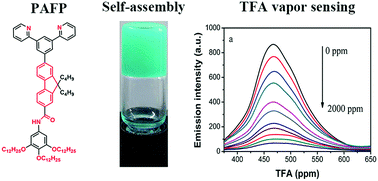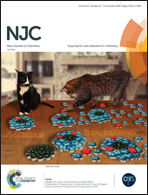A novel aggregation-induced-emission-active supramolecular organogel for the detection of volatile acid vapors†
Abstract
It is of great importance to develop a convenient, portable and rapid detection method for volatile acid vapors because exposure to them could harm the human body. Hence, an organogelator PFAP based on multi self-assembly driving forces and aggregation-induced emission (AIE) characteristics was designed and synthesized. The self-assembly behavior and photophysical properties of PFAP were also studied. Gelator PFAP can form a stable organogel in selected solvents. The results of 1H NMR spectroscopy and X-ray diffraction analysis reveal that hydrogen bonds and π–π interactions play important roles in the gelation process. PFAP exhibits remarkable AIE behavior originated from restricted intramolecular motion (RIM). Furthermore, the xerogel-based PFAP film emits strong cyan fluorescence and could be used as a chemosensor to detect volatile acid vapors with excellent performance owing to its large surface area, AIE properties and amplified fluorescence quenching. The above-mentioned results suggest that the organogelation of AIE materials is of assistance in the rational design of efficient chemosensors for gas detection.



 Please wait while we load your content...
Please wait while we load your content...